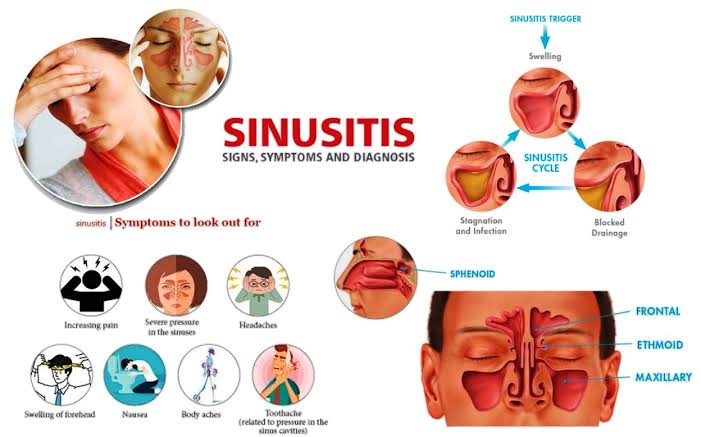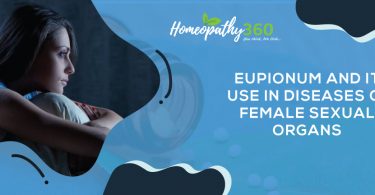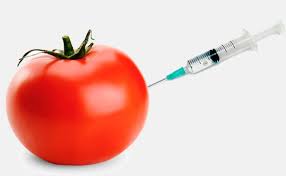
Sinus Infection (Sinusitis): Types, Causes, Symptoms and Treatment with Homeopathic Medicine
ABSTRACT : Sinusitis is a condition during which the cavities round the nasal passages become inflamed. Sinusitis is one among the foremost common of all the respiratory infections which interferes with patients’s quality of life and loss of labor productivity. The explanation for sinusitis is multi factorial, anatomic, genetic and environmental which results in various cycle of infection, swelling and blockage. With proper selection of remedy supported totality of symptoms and constitutional approach Sinusitis are often managed in homoeopathy.
KEYWORDS : Sinusitis, Homoeopathy
INTRODUCTION: Sinusitis is an inflammation of the mucosa of the paranasal sinuses. It rarely occurs without concurrent inflammation of the nasal mucosa (rhinitis) and is therefore commonly mentioned as rhinosinusitis. While the etiology is usually viral, it’s going to even be bacterial or fungal (especially in immunocompromised patients). The condition is typically self-limiting, but if it lasts longer than 12 weeks it’s considered chronic. the first symptoms are purulent rhinorrhea and facial pain (particularly when leaning forward). it’s classified chronologically into following categories • Pansinusitis: inflammation of all sinuses on one or each side • Acute sinusitis: inflammation of the sinuses for 12 weeks • Recurrent acute sinusitis: four or more separate episodes of acute sinusitis that occur within 1 year, with a minimum of 8 weeks of symptom resolution between episodes • Rhinosinusitis: simultaneous inflammation of the nasal mucosa and sinuses:
Epidemiology : Peak incidence: early fall to early spring Sex: ♀ > ♂
Etiology Pathogens Viral (most common) Bacterial Fungal rhinovirus, coronavirus, adenovirus, influenza, and parainfluenza viruses S. pneumoniae, H. influenzae M. catarrhalis S. aureus E. coli Klebsiella Aspergillus Rhizopus oryzae
Route of transmission: droplet transmission, particularly in winter months
Risk factors Preexisting viral Ventilation disorders of the sinuses Foreign body Rhinitis Odontogenic infection Bronchial asthma Analgesic Intolerance upper tract infection (URTI)
Hypertrophy of nasal turbinates
nasal polyps
deviation of septum
cystic fibrosis primary ciliary dyskinesia Wegener granulomatosis
allergic inflammation immunodeficiency
Concha bullosa Foreign body lodged within the cavity (particularly seen in children). spread of pathogens via nasal mucosa leads to unilateral maxillary sinusitis NSAIDs Aspirin Pathophysiology: Sinusitis is triggered by three factors: obstruction of sinus drainage pathways (sinus ostia), ciliary impairment, and altered mucus quantity and quality which causes triggered stasis of secretions inside the sinuses results in proliferation by various pathogens. Recurrent, untreated/complicated acute sinusitis may cause chronic sinusitis.
CLINICAL FEATURES: CONDITION SINUSITIS ADDITIONAL FEATURES
Acute viral rhinosinusitis
Acute bacterial rhinosinusitis
Fungal rhinosinusitis
Fever (∼ 50% of cases), headaches, general malaise, myalgia Facial pain or pressure, erythema, and swelling over the affected area thanks to inflammation Maxillary sinuses (most commonly affected): over the cheeks (mimics dental pain) Superomedial location of the draining ostia → drainage of secretions must occur against gravity → stasis of secretions → increased susceptibility to infection Frontal sinuses: lower forehead
Ethmoidal sinuses: nasal bridge and/or between the eyes or retro-orbital pain Sphenoid sinuses: located within the sphenoid bones near the nervus opticus and pituitary . These are the foremost posterior sinuses. Transillumination may show opacification Occasionally, acute otitis (earache) Other manifestations of URTI like pharyngitis (sore throat, cough) Persistent symptoms ≥ 10 days without clinical improvement OR ≥ 3 initial days of severe symptoms, fever (> 39°), facial pain, or purulent nasal discharge OR Symptoms initially improve then worsen after 5–6 days (double worsening)
Noninvasive Allergic fungal: features of asthma and other atopic manifestations Fungal mycetoma: unilateral complaints; usually involves the sinus Invasive Acute fulminant rhino-orbital-cerebral mucormycosis: epistaxis and dark ulcers on the septum, palate and turbinates; acutely ill with altered mental status Chronic rhinosinusitis May present acutely without improvement of symptoms or insidiously over months to years ≥ 2 of the following: Mucopurulent drainage (anterior, posterior, or both) Nasal congestion Facial pain Anosmia or hyposmia and inflammation as suggested by: Purulent mucus or edema within the middle meatus/anterior ethmoidal area during anterior rhinoscopy Polyps within the nasal cavity/middle meatus Imaging showing inflammation of the paranasal sinuses .
Chronic rhinosinusitis without nasal polyps: anatomical abnormalities (septal deviation, tumors), dental disease
DIAGNOSIS: Diagnosis of acute cases is typically established clinically; However, imaging or endoscopy should be considered if symptoms fail to enhance within 7 days of diagnosis or worsen during the initial management of acute bacterial rhinosinusitis. A clinical diagnosis of chronic sinusitis should be confirmed with objective documentation of sinonasal inflammation, which can be accomplished using anterior rhinoscopy, nasal endoscopy, or computerized tomography .
Laboratory tests: to work out underlying condition if suspected (e.g., nasal cytology rhinitis , HIV test, sweat chloride test for cystic fibrosis)
Imaging
o X-ray of sinuses; (poor sensitivity)
o CT of sinuses (imaging modality of choice)
o MRI could also be considered to verify soft tissue extension in invasive disease.
o Nasal endoscopy
o Biopsy and culture could also be performed (hyphae in fungal disease, eosinophils in
allergic sinusitis).
HOMOEOPATHIC MEDICINE FOR SINUSITIS:
SEPIA OFFICINALIS:
During researches it is seen that sepia has marked action on sinusitis as it cover different kind of headaches vertigo, morning headache,violent congestion headaches especially when stooping,otalgia,spasmodic pain and tearing in bones of face, neuralgic pains of face, Swelling and inflammation of nose, especially at tip. Hardened mucus in nose. Anosmia ,Fetid smell in nose. Ozaena, blowing of large lumps of yellow green mucus or yellow green membranes, with blood, from the nose. Dry coryza. Dry coryza, especially of left nostril. Dry mucus, which causes an obstruction in nose. Violent fluent coryza, with sneezing, pain in occiput, and drawing in limbs.
PULSATILLA: Nose Coryza; stoppage of right nostril, pressing pain at root of nose. Loss of smell. Large green fetid scales in nose. Stoppage in evening. Yellow mucus; abundant in morning. Bad smells, as of old catarrh. Nasal bones sore.
LYCOPODIUM: -Sense of smell very acute. Feeling of dryness posteriorly. Scanty excoriating, discharge anteriorly. Ulcerated nostrils. Crusts and elastic plugs . Fluent coryza. Nose stopped up. Snuffles; child starts from sleep rubbing nose. Fan-like motion of aloe nasi.
PHOSPHORUS: -Fan-like motion of nostrils. Bleeding; epistaxis instead of menses. Over-sensitive smell. Periostitis of nasal bones. Foul imaginary odors . Chronic catarrh, with small hæmorrhages; handkerchief is always bloody. Polypi; bleeding easily . Face Pale, sickly complexion; blue rings under eyes. Hippocratic countenance. Tearing pain in facial bones; circumscribed redness in one or both cheeks. Swelling and necrosis of lower jaw .
KALIUM BICHROMICUM: Snuffles of children, especially fat, chubby babies. Pressure and pain at root of nose, and sticking pain in nose. Septum ulcerated; round ulcer. Fetid smell. Discharge thick, ropy, greenish-yellow. Tough, elastic plugs from nose; leave a raw surface. Inflammation extends to frontal sinuses, with distress and fullness at root of nose. Dropping from posterior nares . Loss of smell. Much hawking. Inability to breathe through nose. Dryness. Coryza, with obstruction of nose. Violent sneezing. Profuse, watery nasal discharge. Chronic inflammation of frontal sinus with stopped-up sensation.
HYDRASTIS CANADENSIS: Thick, tenacious secretion from posterior nares to throat. Watery, excoriating discharge. Ozæna, with ulceration of septum. Tends to blow nose all the time.
SPIGELIA ANTHELMIA: Nose.–Forepart of nose always dry; discharge through posterior nares chronic catarrh, with post-nasal dropping of bland mucus.
DISCUSSION AND CONCLUSION: Homoeopathy is a system of medicine in which treatment is based on similarity of symptoms. There are many more remedies for sinusitis in homoeopathy. With the selection of similar remedy based on totality of symptoms can successfully manage the case.
REFERENCES:
1. Hwang PH, Patel ZM. Acute sinusitis and rhinosinusitis in adults: Clinical manifestations and diagnosis. In: Post TW, ed. UpToDate. Waltham, MA: UpToDate. https://www.uptodate.com/contents/acute-sinusitis-and-rhinosinusitis-in-adults-clinical-manifestations-and-diagnosis.Last updated: November 8, 2016. Accessed: February 16, 2017.
2. Chow AW, Benninger MS, Brook I et al. IDSA Clinical Practice Guideline for Acute Bacterial Rhinosinusitis in Children and Adults. Clin Infect Dis . 2012; 54 (8): p.e72-e112. doi: 10.1093/cid/cis370 . | Open in Read by QxMD
3. Rosenfeld RM, Piccirillo JF, Chandrasekhar SS, et al. Clinical Practice Guideline (Update), Adult Sinusitis Executive Summary. Otolaryngol Head Neck Surg. 2015; 152 (4): p.598-609. doi: 10.1177/0194599815574247 . | Open in Read by QxMD
4. Patel ZM, Hwang PH, Deschler DG, Calderwood SB, Bond S. Uncomplicated Acute Sinusitis and Rhinosinusitis in Adults: Treatment. In: Post TW, ed. UpToDate. Waltham, MA: UpToDate. https://www.uptodate.com/contents/uncomplicated-acute-sinusitis-and-rhinosinusitis-in-adults-treatment.Last updated: January 15, 2017. Accessed: April 19, 2018.
5. Raz E, Win W, Hagiwara M, Lui YW, Cohen B, Fatterpekar GM. Fungal Sinusitis. Neuroimaging Clin N Am. 2015; 25 (4): p.569-576. doi: 10.1016/j.nic.2015.07.004 . | Open in Read by QxMD
6. Morcom S, Phillips N, Pastuszek A, Timperley D. Sinusitis.. Aust Fam Physician. 2016; 45 (6): p.374-7.
7. Rosenfeld RM, Piccirillo JF, Chandrasekhar SS et al. Clinical practice guideline (update): Adult sinusitis. Otolaryngol Head Neck Surg. 2015; 152 (2S): p.S1-S39. doi: 10.1177/0194599815572097 . | Open in Read by QxMD
8. Stevens WW, Schleimer RP, Kern RC. Chronic Rhinosinusitis with Nasal Polyps. The Journal of Allergy and Clinical Immunology: In Practice. 2016; 4 (4): p.565-572. doi: 10.1016/j.jaip.2016.04.012 . | Open in Read by QxMD
9. Hulse KE, Stevens WW, Tan BK, Schleimer RP. Pathogenesis of nasal polyposis. Clinical & Experimental Allergy. 2015; 45 (2): p.328-346. doi: 10.1111/cea.12472 . | Open in Read by QxMD
10. Harrison T, Kasper D, Hauser S, Jameson J, Fauci A, Longo D et al. Harrison’s principles of internal medicine. 20th ed. New York: McGraw-Hill Education; 2018.
11. Robbins, S., Cotran, R., Kumar, V., Abbas, A. and Aster, J., 2015. Pathologic Basis Of Disease. 9th ed. Philadelphia, PA: Saunders Elsevier.
12. Ralston, S., Strachan, M., Britton, R., Penman, I. and Hobson, R., 2018. Davidson’s Principles & Practice Of Medicine. 23rd ed. Edinburgh: Elsevier.
13. Boericke W., 9th Edition, New Manual of Homoeopathic Materia Medica and Repertory; Augmented, B. Jain Publisher (P) Ltd., New Delhi, (2000).
14. Chaturbhuja Nayak, Vikram Singh, VP Singh, Praveen Oberai, Varanasi Roi, MN Sinha, et al. Homeopathy in chronic sinusitis, A prospective multi-centric observational study. CCRH:2012 February;101,84-91.(cited on 06/02/2012)Available from https://www.researchgate.net/publication/223968995_Homeopathy_in_chronic_sinusitis_A_prospective_multi-centric_observational_study/link/5cb07de992851c8d22e58c85/download
About Author:
Dr. Ashok yadav,
HOD Dept. of Practice of Medicine (Hom.) Dr. M.P.K. Homoeopathic Medical College, Hospital and Research Center. Homoeopathy University, Jaipur.
Dr Bhupendra Arya, Dr. Navneet Kaur , Dr. Dharmendra Saini
MD Scholar, Department of Practice of Medicine (Hom.) , Dr. M.P.K Homoeopathic Medical College, a constituent college of Homoeopathy University, Jaipur.





